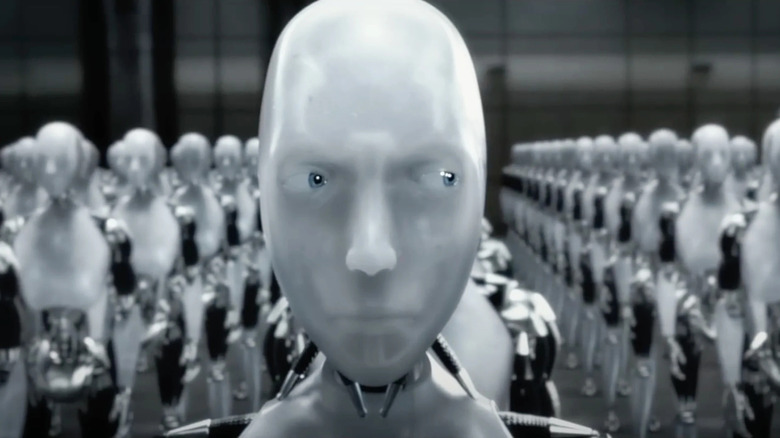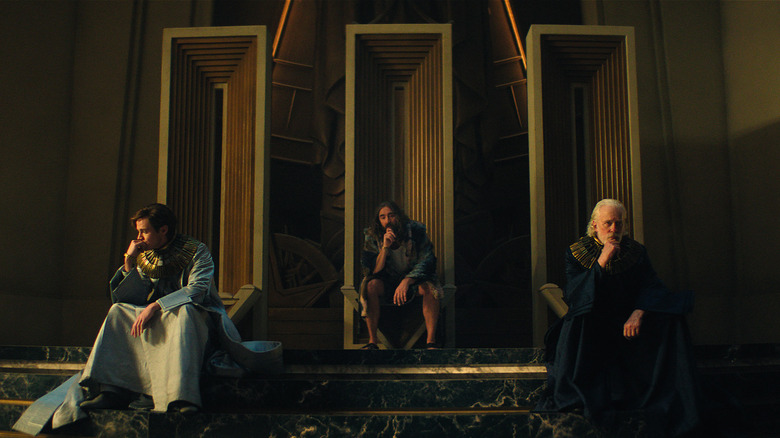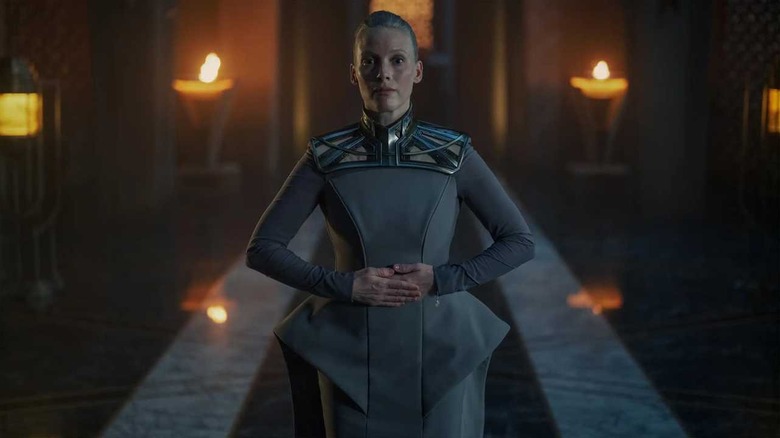Apple TV+'s Foundation Is Set In The Same Universe As A Will Smith Sci-Fi Movie
Warning! Warning! This article contains MAJOR spoilers for the Foundation story. Power down if you don't want to know what's coming next in Apple's show.
"Foundation" is back! Apple TV+'s smash-hit sci-fi drama survived its inter-season spell, and season 3 is officially upon us — as is the impending Asimovian supervillain, "The Mule." The story is just getting started (showrunner David S. Goyer has an 8-season vision for the mammoth imperial storyline), and things are about to get out of hand in a way even the psychohistorian super-genius Hari Seldon (Jared Harris) couldn't have predicted.
While the drama surrounding Trantor and Terminus heats up, I have to keep reminding myself that this is technically the tail-end of a story that Isaac Asimov added to for half a century. It's the punctuation mark on a fanatical history that stretches back 20,000 years. If you go back far enough, it even includes a Will Smith movie.
Remember Smith's 2004 film "I, Robot"? If you don't, I get it. It's not his most memorable role, even compared to his other sci-fi flicks. Despite its tepid reception and forgettable place in cinematic history, technically speaking, "I, Robot" has a special connection to the "Foundation" story. It even takes place in the same universe as Apple's current show — kind of. Let me explain.
What I'm really talking about isn't the movie or the show, but the source material both are built on. I read the "Foundation" novels during the pandemic. (I didn't have as much to do during lockdown, so a seven-book series sounded appealing.) I enjoyed reading them so much that I started going back to Asimov's robot novels, reading through the short stories at the same time. There are over a dozen books all told, and for a while, I kept everything compartmentalized. As I kept reading, though, I started to realize that the two worlds were connected. Then it clicked — they didn't just share a universe. They were both on the same timeline.
Isaac Asimov's sci-fi timeline connects everything
To properly understand the connection between Asimov's robot and Foundation novels, you have to understand that, while they're both in the future, they're dramatically far apart. The robot novels take place anywhere from the mid-20th century to around the year 5,000 A.D. (Basically between now and 3,000 years in the future.) In that time, Asimov wrote dozens of short stories on things like the development of robots, the discovery of interstellar travel, the self-destruction of the Mother Planet Earth, and the colonization of other planets.
After that, he wrote a scattering of novels that sporadically address the phasing out of robots and the spread of humanity across the galaxy. This takes place for thousands of years, during which the Galactic Empire is born. Over 12,000 years, that entity grows to rule over 25 million inhabited worlds. Its power is concentrated on the Imperial capital, the city-planet of Trantor, where a single emperor wields ultimate power. By this point in the story, you're over 18,000 years in the future after the later robot novels end.
By the time "Foundation" starts, the Galactic Empire is in decline. Hari Seldon implements his titular plan to save the impending imperial reset by reducing the inevitable "Dark Age" to come from a projected 30,000 years to a mere millennium. From there, a Second Empire will follow (or so he thinks) and humanity will continue on with business as usual. The key factor for us here, though, is that we're still dealing with the same technology and timeline as the robot novels, just roughly 18,000 years apart.
How Will Smith's I, Robot connects to Foundation
Isaac Asimov connected his robot books and "Foundation" story by having them feed into one another thousands of years apart. He also went one step further by connecting them with a single-character thread. Despite the enormous gap in time between the two stories, there is one individual who crosses over between universes: Eto Demerzel.
Played by Laura Birn on the show and depicted as a male robot in the books, Demerzel is a positronic robot who has survived the end of its kind and is still kicking around in Imperial circles at the end of the Galactic Era. While they aren't directly represented in "I, Robot," the character is a direct result of the exploratory robotic inventions addressed in that movie.
The connection goes even deeper, too. (This is where I'm going to get really spoilery.) By the end of the last book in the "Foundation" series, it's revealed that the character we know as Demerzel is actually a synthetic named R. Daneel Olivaw. (The "R." stands for robot.)
Daneel is a recurring and central character throughout the longer robot novels. They are present at the end of Earth's history and are the co-creator of the "Zeroth Law," a special amendment to Asimov's Three Laws of Robotics that supersedes individual human safety for collective human protection. Daneel lives on after the robot novels end and eventually become a counselor to the emperor (where we meet them in the show, too). All this time, Daneel is quietly working on something even bigger than Hari Seldon's empire reboot idea. Daneel is a mentalic (he can use his mind to manipulate others — a concept we already saw in Season 2 of the show) and is working on a project that, if it succeeds, would set humanity on a completely new trajectory, where empires and emperors alike would be pointless. That's a reveal that I'll leave for Goyer and company to build up to in the show. Just remember one word as you watch: Gaia. Enjoy the new season!


